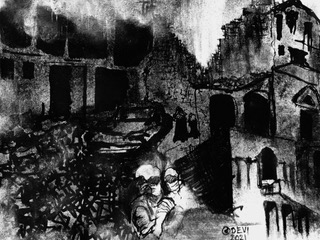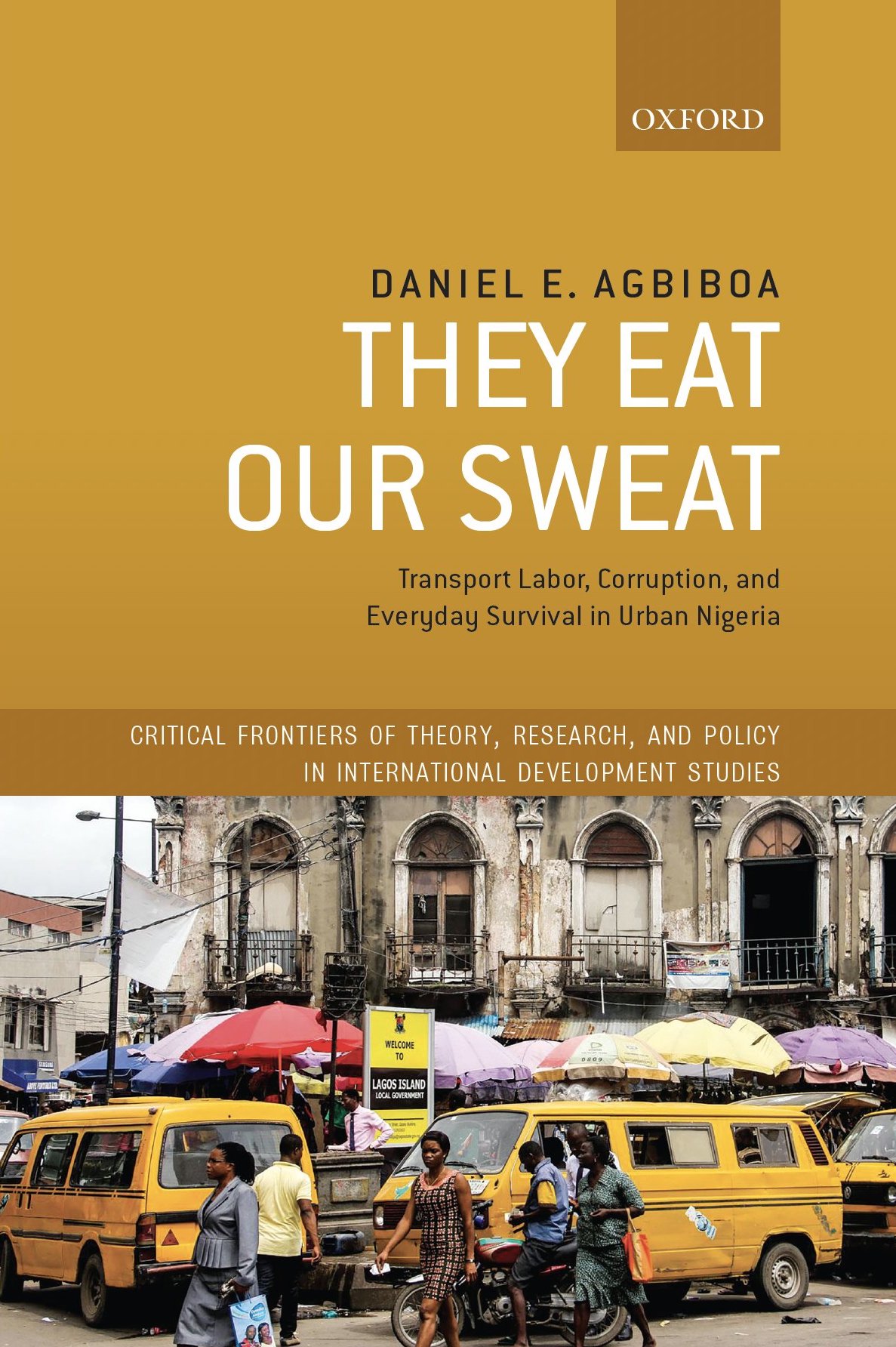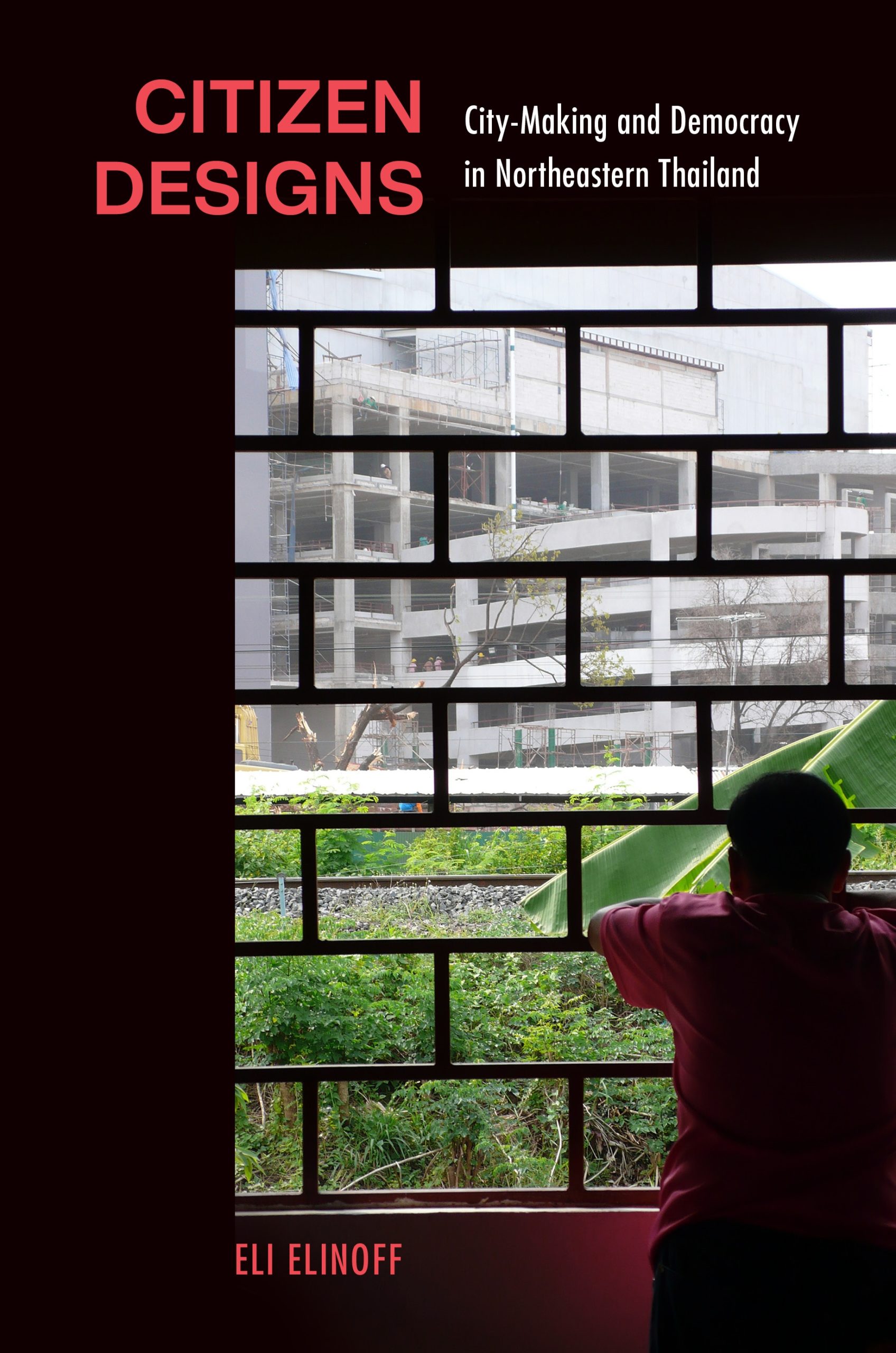A note on the text and illustrations:
This collaboration explores the active role of dust in urban warfare through text and illustrations. Ute, Malini, and Devi debated the political, experiential and aesthetic significance of dust through the distinct textures of urban destruction. Devi gathered the sensibilities that emerged from these discussions, giving expression to cities and dust in charcoal and ink.
Cities never stand still. People construct, maintain, repair, and destroy cities. These processes create dust. Rather than being residual matter, dust is central to the formation and destruction of cities.
Cities generate dust. People struggle and live with dust. Smoke and haze gather particles from industrial production and vehicular emissions; tiny particles from the built environment and microplastics infiltrate bodies. These regular appearances of dust that are fundamental to the everyday urban are surreptitious.
Not so catastrophic dusts. Their spectacular forms and shapes are difficult to ignore. Sandstorms carry particles across vast distances, floods are awash with sediment and dirt, mudslides rush into cities, and bushfires create ashen smoke which envelops cities in thick haze. Dust enters urban ecologies through unpredictable climatic events.
But even beyond climatic hazards, dust surfaces in other, more sinister forms. Premeditated all-too-human orders generate the dust of destruction. Lingering dusts from modern warfare that aims at destroying cities and lives is the ultimate signifier of extermination. Aerial warfare especially mobilizes, generates and leaves behind dust. It aims at and epitomizes urban devastation.
In what follows, we open the histories and contemporary terrors of war dust, its afterlives in motion, hyperactivities, and indestructible forms in cities to scrutiny. In its destructive potential, invisibility and durability dust haunts cities, their pasts and presents, erasing and generating urban subjects and subjectivities.
Terrors of Dust
C
ities and war go together. Cities are the nodes for the science of warfare and its consequences; as the world urbanises armed conflict increase. From the 1930s, when ariel bombings ruined cities in Africa, Europe, the Middle East, Russia, Asia and the Pacific, until the recent bombardment of cities in Syria and Iraq, war dust has pulverized urban worlds. The Second World War destroyed Warsaw, Rotterdam, Milan, London, Paris, Dresden, Düsseldorf, Cologne, Hamburg, Tokyo, Hiroshima and Nagasaki; the recent bombings of Aleppo, Holms and several cities in Iraq make evident the perpetuity of urban destructive dust.

Aerial and area bombing weaponize dust for urban decimation. Such strategies of pulverization aim to destroy industries, neighbourhoods, lives and morale. Bellowing off buildings, sweeping across ground, spiralling into the air, and seeping into waterways, warfare dust reaches into every nook and cranny.
The composition of warfare dust is lethal. The nature of crystalline and powdery explosives and poison gases unleashed as incendiaries on hundreds of cities during World War II included napalm, thermite, chlorine trifluoride, and white phosphorus. Incendiaries burn at over 2,700 degrees Celsius; they are designed to ignite and prolong fires. They ensure that neither urban infrastructures nor people survive. Smoke, ashes and gases emit from concrete, steel, iron and wooden infrastructures set ablaze or are blown to fragments.
Attacks with explosives, incendiaries, chemical and particle dust intend to maximize the reach of destruction. By incinerating large areas and enveloping cityscapes and people in toxic clouds, dust makes destruction all-pervasive and inescapable.
War assaults the entire being of cities. Writing about “place annihilation” through warfare, Kennith Hewitt reminds us how aerial war erases the urban at large. During World War II, area bombing in Europe and Japan targeted densely populated and combustible neighbourhoods, mostly working class settlements that had grown around cultural centres, industrial manufacturing sites, coal mines, and steelworks. Area bombing outside of battle zones pulverized 750km2 of urban built-ups in Germany and Japan (Hewitt, 1983).
Unlike rubble, a solid form of destruction residue that was measured and reused during and after the war, dust created through aerial bombardment remains a volumetric unknown. 90 Japanese cities were destroyed in the Second World War; their wooden structures turned into ashes. In Germany, four years of air raids by the Allied forces had left large parts of 131 cities buried under 400 million cubic metres of rubble (Hewitt, 1983).
Mixing and mingling in its chemical ways, dust is a force that is a destroyer in and of itself. On 6 August 1945, the city of Hiroshima in the southwestern part of the Japanese archipelago was pancaked by the shockwave of an A-bomb detonation. The traditional houses of this site of the world’s first atomic bombing were made from earth and straw. Every building within a 2-kilometre-radius of the centre of the blast was pulverized; their dusty remains were pushed outward and spread into the air. People outside the direct exposure zone inhaled this neutron-activated dust, which also attached to their skin, irradiating it externally (Sakaguchi et al., 2013).

More recently, prolonged armed conflicts in Syria and Iraq made the relationship between warfare, cities and dust evident. During the battle of Aleppo that lasted from 2012-2016, one of the world’s oldest inhabited cities that stood at the cross-roads of thriving trade routes was ground to rubble. In Iraq, between 2014 and 2017, more than sixty cities and many more villages were bombed out. These wars generated over 70 million tons of conflict debris from residential dwellings alone.

The Afterlife of Warfare Dust
Dust in the destruction of cities is not just momentary. War ensures that cities die and live with dust. In its material composition, vast volumes, changing forms and lethal imprints, warfare dust consumes and decomposes urban landscapes and bodies. Warfare dust destroys national sovereignty and cripples citizenry in known and unknown ways.
In the aftermath of war, instead of infrastructures, homes, markets, factories, places of worship and recreation that provide the engines of urban life, national prosperity and cultural memory, there is rubble, smoke and dust.
It is no coincidence that the demolition industry in Europe took shape in the years following the Second World War: vast numbers of building carcasses had to be demolished in order to make way for the reconstruction of dense urban areas (Blanchard 2002). Ironically, the safest way to do this was through controlled explosion developed in mining - a dust-intensive demolition technique - that has since become a public spectacle the world over.
Warfare dust has an afterlife. It seeps into the present as cities rise out of the ashes and reconstruction imbues urban places with new life. Dust is intrinsic to such processes of renewal, which, however, may take unexpected twists and turns.
As Germany’s war-torn cities were cleared of rubble and rebuilt within a decade, coal mining, steelworks, power stations and cement factories were producing more coal and goods than ever - and ever more hazardous dust. The “economic miracle” supported by the Marshall Plan (European Recovery Program) pushed air pollution in the Ruhr region especially to the limit of what people could endure. This polycentric urbanity that had sprung into life around coal mines was Germany’s industrial powerhouse before and during the war. Yet, toxic particle pollution reached new levels in its aftermath.
Erika Fehse’s (2010) documentary film Wie der Himmel über der Ruhr wieder blau wurde insightfully captures how the smelters were emitting thick clouds of sulphur dioxide and copper particles that settled on neighbourhoods and forests since the 1950’s. Workers, doctors, and scientists formed a citizen association to fight for better air as silicosis, asthma, cancer, stunted growth in children and dying gardens could no longer be tolerated. The fight against dust in the Ruhr conurbation also signalled a new political direction in the 1950’s; through their actions to protect children and the urban environment people sowed strong foundations for democracy after fascism. They battled on for another 30 years, campaigning against acid rain that originated from the heightened smokestacks of their workplaces. These killed forests in Sweden and further afield.
Chemical dust leaves invisible imprints. The toxic dust exposure from the World Trade Centre after the 9/11 attacks - where dust hung in the air for more than three months - gives an important indication of how materials that are used to build cities in the first place leave persistent traces in the wake of their destruction.
Warfare dust leads to urban destruction in unanticipated ways. The world’s largest non-nuclear explosion occurred not in the context of battle, but the long-drawn out consequences of civil war. In August 2020, over 500 metric tons of ammonium nitrogen detonated in the Beirut harbor. Here, 2,750 tons of the highly combustible fertilizer had been stored for years in a warehouse under dubious circumstances; it became unstable, and a large portion exploded through heat from a nearby fire. The shockwaves destroyed swathes of Lebanon’s once vibrant capital city that was still recovering from the ruinations of the civil war (1975-1990), and that has since been struggling with corruption, economic downfall, and environmental destruction. A huge orange plume of active poisonous gases mixed with Beirut’s already dangerous air pollution levels - “a combination of fossil fuel combustion, sea salt, and mineral dust” and with the dust of collapsing buildings encrusting the city after the explosion.
Hyperactive Dust
Warfare dust is deliberately volatile. If the dust from building and rebuilding cities is contained and stabilised, warfare dust are hyperactive surfaces. The horror of exposure to toxic dusting from the air, to smoke and large volumes of choking powder flying off detonating buildings lies in dust’s power to remain in bodies, cityscapes, and minds long after.
Metal dust, cement, glass, poisonous powders and radioactive earth shower down. The noise. The smell. The visibility. The invisibility. The pain. The horror of being in the thick of it. The horror of living with its memories. The horror of its perennial infiltration. Philosopher Michael Marder’s object lesson rings true here: dust “disrespects the partitions between the regions of earth and air, air and water, water and earth, nature and culture” (Marder, 2016: 153).
Lethal dust operates through elements. Through surfacing and resurfacing. Powdery dust is chemically active because its granulate surface is much larger than the geometric area it fills. Like skin, the granular texture of dust multiplies the contact zone of substances, making it a hyperreactive zone that is chemical rather than geometrical (Bachelard, 2018: 18).
Here lies another cruel irony of dust: the radioactive surface soil at Hiroshima that settled into human tissue was set in motion by a nuclear weapon which would not exist without dust. As Bachelard (2018) theorised in Atomistic Intuitions, the atom only became thinkable when particles of dust in a ray of light sparked the search for knowledge of the invisible.
Cities harbour the danger of uncontrolled explosive destruction beneath the ground. Duds, the air bombs that failed to detonate during wars have been silently lying under the surface of reconstructed cities. Construction workers suddenly find them when the ground is broken for building cities. With each controlled detonation of these bombs, a slice of history is buried once again. Pulverized, bombs reach their final stage of being, indestructible at last.
Moving, Indestructible, Haunting
Dust in motion - the shockwaves, flowing dense clouds of particulate matter that change their shape, hover, or drift in the wind - is not a mere symbol of an event unfolding. Moving between visibility and invisibility, dust is used deliberately as a signal to mark the target of bombs. Even in photographs, films and illustrations, airborne dust retains at once its indexical nature as well as its mobility.
Hence dust’s hyperactive and destructive power. This is the paradox of dust that Bachelard (2018) noted in 1933: Dust is the final result of all destruction, yet it is indestructible - like traumatic memory. Dust stirs cities, bodies and memories that never really settle.
Warfare dust enables us to understand cities in the moments of their destruction and beyond. More than an agglomerate of the planner’s dream or a singular site of sovereign destruction, cities accrue meanings in everyday battles over dust. Spaces and lives shattered and rebuilt, and haunted and recreated. Lost and won.
References:
Bachelard G (2018) Atomistic Intuitions: An Essay of Classification. Albany: SUNY Press.
Blanchard B (2002). A history of explosive demolition in America. In Proceedings of the Annual Conference on Explosives and Blasting Technique. International Society of Explosives Engineers, pp. 27–44
Hewitt K (1983) Place annihilation: Area bombing and the fate of urban places. Annals of the Association of American Geographers 73(2): 257-284.
Marder M (2016) Dust (Object Lessons). Kinde edition. London: Bloomsbury.
Sakaguchi A (2013) Soil particle size measurements for the calculation of the spread of dusts blown up by the explosion of the Hiroshima atomic bomb. In Aoyama M and Oochi Y (eds) Revisit The Hiroshima A-bomb with a Database Volume 2. Hiroshima City, pp. 15--23.
Ute Eickelkamp is an honorary Senior Lecturer in Industrial Design in University of New South Wales.
Malini Sur is a Senior Lecturer in Anthropology at Western Sydney University.
Devi Chettiar is an artist and illustrator who is originally from India, and has been living and working in London.




















